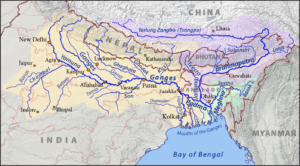In news : As per the QCI survey, around 28 percent of the government-owned waterbodies in the Ganga basin are dried up
Who conducted the survey?
It was conducted by the Quality Council of India (QCI), an autonomous body established by the Government of India in partnership with ASSOCHAM, CII and FICCI.
States/water bodies covered
- Ponds, tanks, and lakes in the Ganga river basin in Uttar Pradesh, Jharkhand, Uttarakhand, Bihar and West Bengal
- The team studied 578 water bodies and found that 411 were surrounded by human settlement
Purpose of the survey
To do a 100 percent mapping of all government-owned water bodies in Ganga districts for improvement and rejuvenation of water bodies that are either dried up or working at less than full efficiency.
What does the survey say?
As per the census survey of ponds, tanks, and lakes in the river basin, the water bodies in Uttar Pradesh, Jharkhand, Uttarakhand, Bihar and West Bengal have dried up.
The findings show that 16 percent of the water bodies in the Ganga basin were eutrophic, and only 56 per cent were functional. Following are the statewise findings of the survey:
Jharkhand
- Out of the 53 water bodies assessed, 13 per cent have dried up while 72 per cent were functional, and 15 per cent were eutrophic.
- About 96 per cent of the water bodies don’t have any type of function while 85 per cent are surrounded by solid waste.
Uttar Pradesh
- QCI team assessed 329 water bodies in the state and found that 37 per cent have dried up.
- About 93 per cent of the water bodies don’t have any type of fencing; 53 per cent of functional water bodies were found to be not turbid; 48 per cent of water bodies had solid waste around them, and 69 percent water bodies have settlements around them.
- Ghazipur district has the maximum number of functional water while Bhadohi District has a maximum number of eutrophic water bodies.
Bihar
Out of the 39 water bodies assessed, 31 per cent have dried up, 31 per cent were eutrophic, while 38 per cent were functional in the state.
Uttarakhand
The team assessed 10 water bodies out of which 5 had dried up, 3 were functional while 2 were eutrophic in the state.
West Bengal
- Out of the 147 water bodies assessed, 11 per cent have dried and 16 per cent were eutrophic and 73 per cent were functional in the state.
- About 90 per cent of the assessed water bodies don’t have any fencing and 63 per cent have solid waste around them.

Quality Council of India
- It is an autonomous body of Department of Industrial Policy and Promotion, Govt. of India
- QCI was set up in 1997 jointly by the Government of India(under the Societies Registration Act ) and the Indian Industry represented by the three premier industry associations i.e.
- Associated Chambers of Commerce and Industry of India (ASSOCHAM),
- Confederation of Indian Industry (CII) and
- Federation of Indian Chambers of Commerce and Industry (FICCI),
- The main objectives of QCI are (a) to establish and operate national accreditation structure (b) to monitor and administer the National Quality Campaign
- The Department of Industrial Policy & Promotion, Ministry of Commerce & Industry, is the nodal ministry for QCI
















